Solar eclipse of April 9, 2043
| Solar eclipse of April 9, 2043 | |
|---|---|

|
|
| classification | |
| Type | Total |
| area |
Pacific , western North America , eastern Siberia , Canada , North Pole , Greenland Total: North-eastern Siberia |
| Saros cycle | 149 (22 of 71) |
| Gamma value | 1.0033 |
| Greatest eclipse | |
| place | Siberia, about 60 km north of Atka |
| location | 61 ° 19 ′ N , 151 ° 56 ′ E |
| time | April 9, 2043 6:56:11 PM UT |
| size | 1.0410 |
The total solar eclipse of April 9, 2043 is something special in its form, as it is the only decentralized, but not at the same time only partial solar eclipse of the 21st century. Purely decentralized solar eclipses can only occur in polar regions, which is why the zone of totality is also very far north.
classification
The solar eclipse belongs to the 1262 year Saros cycle 149, which began on August 21, 1664 with a small partial solar eclipse over the Arctic Sea and Siberia (the maximum of this and that eclipse are close together) and will celebrate its last eclipse on September 28, 2926 becomes. All of the eclipses in this cycle occur near the ascending lunar node . The solar eclipse of April 9, 2043 is also the only decentralized, not purely partial and at the same time the first total solar eclipse within Saros 149. This corresponds to 2.3% of all 43 total and annular eclipses of this cycle.
It is the successor to the partial solar eclipse of March 29, 2025 , which can also be seen from Germany. During the next solar eclipse of this cycle in 2061, the umbra will cover almost all of Asia. In Central Europe, the sun has not yet risen at this point, so this solar eclipse will remain invisible in Germany.
There are no noticeably pronounced solar eclipses within Saros 149, so the longest total solar eclipse of this cycle is just 5 minutes and 6 seconds long, whereas the theoretical maximum for this is currently around 7.5 minutes.
Decentralized solar eclipse
Decentralized solar eclipses are very rare; they only make up about 1.3% of all total and ring-shaped solar eclipses (partial solar eclipses can basically be described as decentralized).
An eclipse is decentralized when there is no straight line between the sun, the moon and any point on the earth's surface. This is never the case with a partial solar eclipse, as the umbra of the moon does not hit the earth anywhere, with a total or ring-shaped eclipse this is possible in exceptional cases. The earth is then in the umbra of the moon, but this just misses the earth's surface.
The form of the totality cannot be viewed from the earth, since the sun is directly above the horizon, which means that it is of little interest to eclipse tourists.
Nor can a duration or a path width of this total phase be specified, since these are parameters that depend on the position on the earth's surface.
course
The solar eclipse begins as a partial solar eclipse in the early morning hours local time over the Pacific and moves across the entire North Pacific. In its partial phase, the solar eclipse can also be seen on the American west coast, in Canada and Alaska, but also on Hawaii .
Nearly two hours after the penumbra of the moon touched the ground, starts at 18:45, the (theoretical) total phase of the eclipse. The earth is within the umbra of the moon for a total of 20 minutes and 45 seconds, the maximum is reached at 6:56 pm and 11 seconds.
Then the moon's shadow moves quickly north and crosses the North Pole and finally crosses Greenland, where the partially covered sun can be seen at sunset.
The entire eclipse from the 1st to the 4th contact only lasts a good four hours, which is below average for a total solar eclipse. (For comparison: the longest total solar eclipse of the 21st century on July 22nd, 2009 can be perceived in its partial phase globally for well over five hours.).
Visibility in Germany
The eclipse cannot be observed in any of Central Europe.
Individual evidence
- ↑ NASA: Graphic of the total solar eclipse of April 9, 2043. Retrieved on February 2, 2017 (English).
- ^ F. Espenak: NASA - Catalog of Solar Eclipses of Saros 149. Retrieved February 2, 2017 .
- ↑ Total Eclipse of the Sun: 2043 April 09. Retrieved June 28, 2017 .